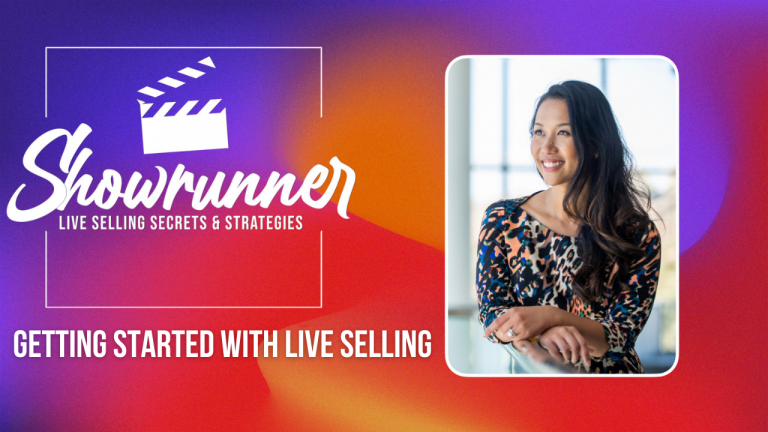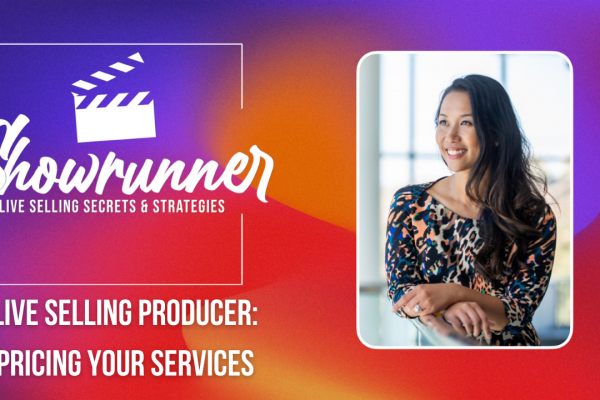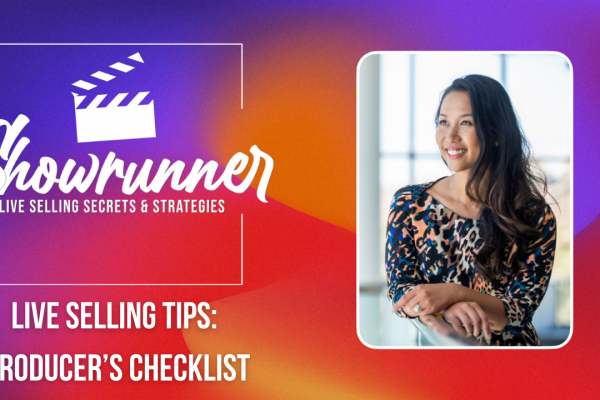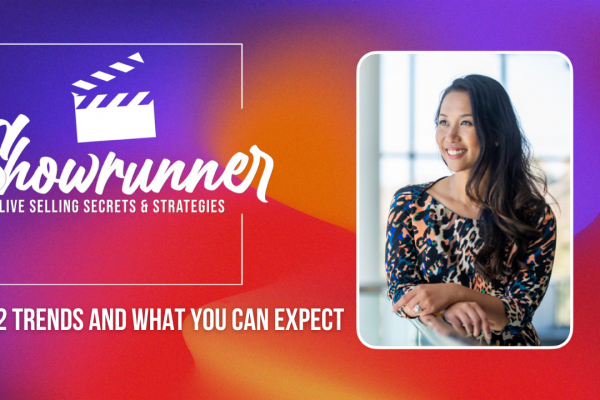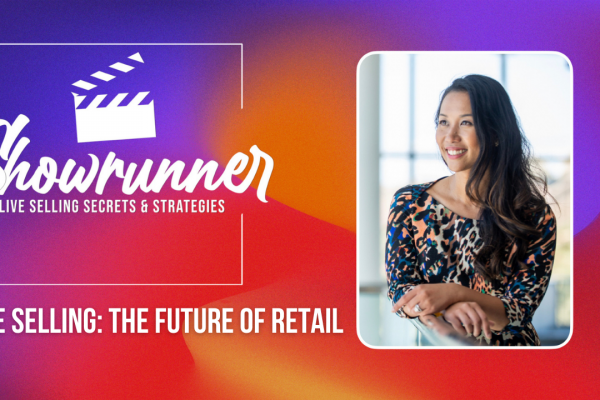When you’re getting started with live selling, you need to know that live shopping isn’t your momma’s QVC. Let me explain what that means. Back in the day, you’d have people sitting in their homes watching QVC or the Home Shopping Network and they’d call and order products when they wanted to buy. Sometimes they’d get through. Sometimes not.
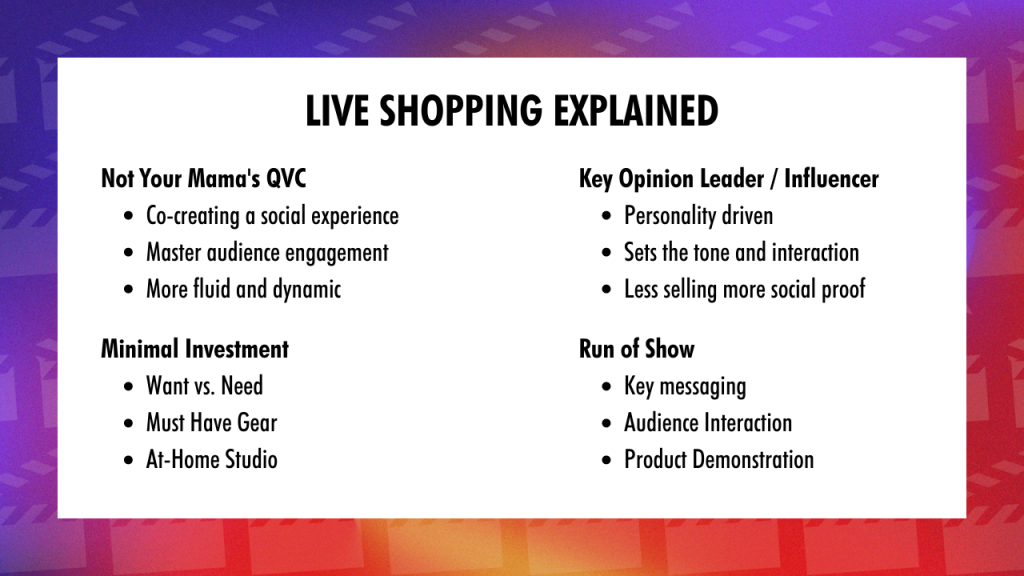
Now, it’s a much more interactive experience. When you are live selling, you’re creating a social experience between you and the consumer. You’re engaging in real time. You can immediately see their questions, their comments, and their enthusiasm and can even see the sales in real time.
“Can you flip it out? Does the camera do this? What does it smell like?” Whatever, right? You’re able to master audience engagement. You can change it up if it isn’t working because you can see what your customers are looking for – they’re telling you.
In this post, we’re going to discuss
- The differences between QVC and live selling
- How to build engagement
- In-house vs. production house
- Choosing & training show hosts
- Planning your creative brief, storyboards, & run of show
- How to be a strategic partner
Watch the full episode
On this season of Showrunner, we’re jumping into the world of live selling. Blending entertainment with instant checkouts, live commerce offers retailers, brands, and content creators a new channel to reach and engage audiences. Live shopping has opened doors for on-camera talent, influencers, and even remote live video producers. So listen, if you’re not already offering remote live video production to e-commerce clients, NOW is the time to get started.
Focus on the Viewers & Building Engagement
One of the most important things you can do when getting started with live selling is leave room to make the show fluid and dynamic. This is very helpful because, more often than not, when we talk about the Home Shopping Network or QVC with clients they think that it needs to run on a very tight schedule. You can’t answer all the questions in that setting. And so they leave a lot of engagement and improv on the cutting room floor. This is your opportunity to really build that audience engagement and show them how different and how powerful streaming can be.
As live streamers and content creators, that’s what we do. We’re building that relationship week after week. The other thing about live shopping is that it requires minimal investment. And I say that as someone who loves the gear and the tech.
What about the Gear?
But when we’re working with clients, we need to let them know the difference. We need to separate the wants from the needs. You need an ethernet cable, a good camera, and a good microphone to create video. You don’t need a Rodecaster Pro (although they’re really cool). When you’re working with clients, it’s important to make that distinction with them.
Don’t over-complicate it when you are working with clients. Ask yourself, is this going to be in a studio? Is this going to be at a showcase? A retail location? Or is it a home studio? What you want to do is make sure that they have the gear necessary to produce a successful broadcast. You don’t want to overwhelm them with gear acquisition syndrome.
While we’re talking about minimal investment, remember that there are different things that you can do where you can leverage B roll video, testimonials, and all the different things to make a live shopping experience really engaging and make it a lot of fun for your viewers.
Key Messaging
Live shopping is different from the QVC days. You don’t need a TV presenter or a host reading off a teleprompter. Successful streams create a FOMO effect. They’re personality driven. You need a key opinion leader or KOL. Or even an influencer who knows how to sell and isn’t icky about it because it’s a product or products that they’re really passionate about. It’s less hard selling and more social proof.
As live selling producers (as Showrunners), we need to be mindful of the key messaging. What is the hero of this live selling production? Because more often than not, generally what happens is that I’ll have a client who has made a big investment. They’ve signed on the dotted line and they’ve committed to everything. Likely the live shopping platform was expensive for them and they have a tight budget. And so they end up wanting to add as many SKUs, as many products and different things as possible. What happens is that you lose the key messaging for the audience.
Make sure that your Run of Show includes audience interactions. You’ll want a point in time where you can do a Q+A, where questions can come through. You’ll also want a time for your product demonstration. As a live selling producer, you’ll need to think about what that looks like and sounds like. What kind of gear does the host need to be able to do that? If it’s too complicated to demo on air, you’ll want to know that so that you can play B-roll instead.
In-House or Production House?
Should the client be in-house? Should their marketing team or their creative team or their video team be responsible for this or should you hire out a production house? Let’s talk about the differences so you’re ready to have these discussions with clients and potential clients.
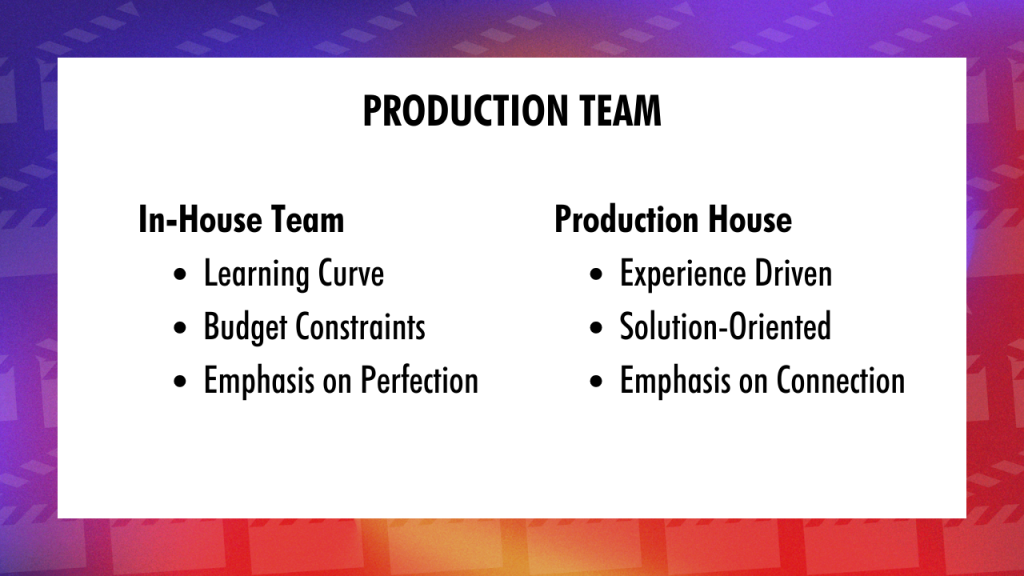
Let’s be honest. When you have an in-house team and they’re relatively new to live streaming, there’s a learning curve. There’s even a learning curve when it comes to setting up a Facebook shop. What are the guidelines? Are there things you can sell and can’t sell? How do you do shipping? How do you add SKUs? All that stuff.
Sometimes in-house teams don’t have dedicated time to really sit down and analyze what a successful Run of Show looks like or they have budget constraints. I’ve had clients who have shown up to Zoom meetings with their janky built-in webcams and asked if they could do live shopping with those.
Remember, as live selling producers, it’s our name on this event. You’re going to want to add your projects to your sizzle reel, to your media kit, your pricing, your landing page… so you’ll need to able to help clients through the process to make sure that their live selling event really shines. Set those expectations up front.
Set Expectations
If you’re going to go with an in-house team, then you need to do it right. You’ll need to train that team on how to do a live shopping event. Create a workshop. Get them hands-on and walk them through what the process will be like. That means doing an audit of the Run of Show, having them do demos, understanding the nuances of the live shopping platform, the gear, the tech rehearsals. Not just the team, but the talent, as well.
If you want to get through all this a lot faster, that’s where you hire a production house.
This is an opportunity for you because experience driven means that we’ve done this before. We’ve walked the walk. We talk the talk. We’re showing up on Amazon Live, we’re working with Press N’ Sow. We’ve got our merchants. We’ve got all the things, so we know how it works.
When you’re working with a production house, we’re solution oriented. Now let me explain to you what that means. A client can come to me and have the craziest idea. They may want confetti dropping from the sky. I can give them options. We could do that with overlays or we could get some confetti guns. Whatever they want to do, right?
You just have to let me know how it’s going to look like, sound like, and I’ll build it out for you. Because as producers, we’re solution-oriented.
You want to let your clients know that you’re there to help them be successful. You are there to bring out the best in their guest. Sometimes you’re also going to be the one to let clients know that it’s not about perfection. It’s about connection… engaging with your audience in real time. Does that live shopping platform enable you to show comments? Can it do graphics, polls? How about quizzes? What’s possible?
In short, as a producer, you’re going to need to know how long will it take you to get your client set up and ready to go?
Show Hosts & Their Capabilities
You’re the showrunner. You’re not just a scene switcher. Your goal is to help your clients have the best, more profitable live selling experience. Finding the best show host is hugely important.
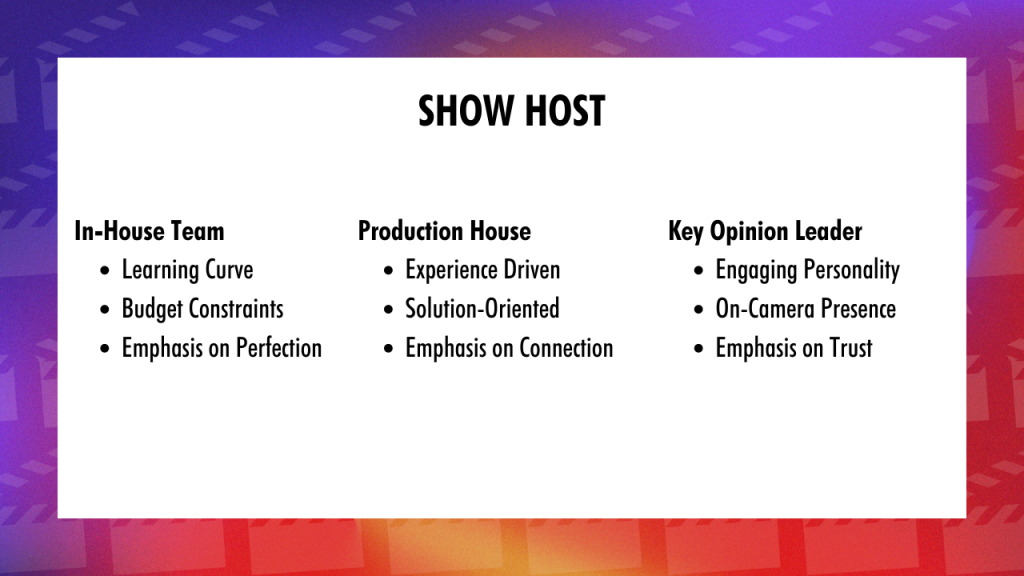
Like I said before, there’s a learning curve. There are budget constraints. There’s an emphasis on perfection. And then sometimes, if they’re doing it in-house, their show host recommendation could be the marketing manager and they might not have that on-camera presence. The marketing manager may be awesome at their job, but being on camera is a whole different thing. If you want to put that person on camera, then maybe hire someone to do media training with the marketing manager.
Pro tip! You can leverage the Ecamm Community to find resources and partners. The Community has producers, on-camera talent, video experts, presenters, and more. You can even find on-camera talent who speak Spanish or Portuguese. All you need to do is ask.
Finding Key Opinion Leaders
Remember that when you’re finding a show host, you need them to be that key opinion leader or influencer. Can this person really captivate an audience from beginning to middle to end? Do they have that on-camera presence? The goal is for them to feel trustworthy when talking to consumers.
Sometimes you may not get to see or meet a show host until the tech rehearsal. If you’re not able to meet the show host in advance, consider checking them out online. Look at the content that they’re creating. See what their camera quality is like. What do they look like? Sound like? What’s their cadence? Their personality?
I’ll ask the client to tell me about the influencer. Did you do an on-camera test? Are they cool? Because unless if you wanted them to read from a script, do they have a teleprompter? Or are you going to ship that out to them? Are you going to give them bullet points? Do they know how to say the specific ingredients in your product? These are all things you need to be thinking about and reminding your client to think about.
Planning Your Creative Brief
You will absolutely want to have a creative brief for each project you work on. The creative brief gives you a high level overview of what the project entails.
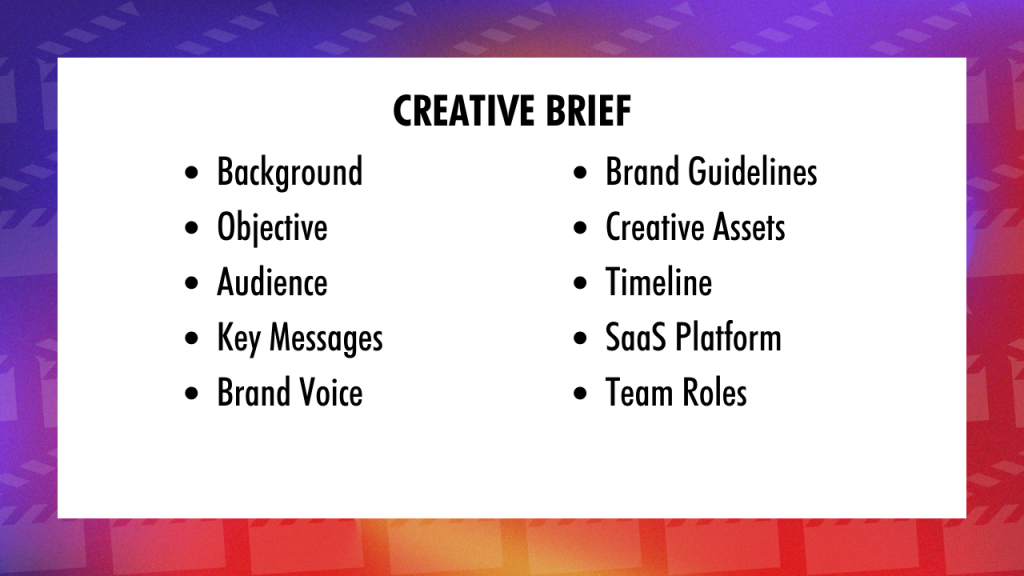
What goes into your creative brief?
- Background on the company
- Objective
- The products
- Brand guidelines
- Brand voice
- Creative assets
- Who is creating what graphics?
- Timeline
- Audience
- Key messages
- Team roles
- Marketing plan
- Host(s) – who and how many?
- Software / SaaS platform
Why Creative Briefs Matter
When I’m working on a creative brief, I always include information about the company, the products, and their background. I also want to know what the objective is. Who is the hero of this live shopping event? Is the hero the product?
Your creative brief should also include the audience. What is the consumer demographic? What is the key messaging for this audience? Knowing this information will help me, as the producer, plan everything out and make sure the event is a success. It’ll affect the run of show, the graphics, the animations, the transitions, the music… even the gear.
Another important aspect of your creative brief are the client’s brand guidelines. What are their fonts and brand colors? Does the client expect you to create the graphics or are they providing everything for you? Put that into the brief. All of this information is going to dictate what the experience is like.
What does the sign up process look like? What are the promo emails going to look like? I really want to know what is this experience? What are the stories? How are you getting people engaged as a producer? I want to be involved in the process as much as possible.
So having said that, then I want to know what’s the timeline for all of this? Depending on how many show presenters you have, how many products, if they have the gear, if they don’t have the gear, what’s the timeline for it? Because you, as the producer, you have to plan out your tech rehearsals and troubleshooting, all of that other stuff.
A good client is a client that follows instructions and a good client that follows instructions also understands the importance of a timeline in the creative brief.
I also want to know what the software as a service platform that they’re currently using and if I’m familiar with it. Does the client have an account manager at the live shopping platform? Is there someone I can call if something goes wrong? I want to have someone that I can get in touch with easily and quickly.
Storyboards
Once I’m done with the creative brief, I’m going to move into storyboarding. This is where I sit down with clients and we build out the entire flow of the event. How does it look and sound and feel. Do we start with a countdown timer or an intro video? Where do they want their logo?
Write out your storyboards and then provide visuals for your clients. The visuals will help clients understand exactly what their event is going to look and feel like. And then walk them through the storyboard. OK, here’s the first shot. You can see it’s a single person with our host and they’ll be demoing this product.
If your host is going to be interviewing, let’s say a data scientist, you could have them side-by-side. During the storyboarding process is a great time to ask who is going to be on camera left and who is going to be on camera right? Confirm that information with your client so you can build it into the storyboard and add the content in.
The storyboard phase is also where you’ll identify where b-roll is going to be played and when Q+A time will be. It’s a visual run of show for your live selling event.


Pro tip! Build out your entire show in Ecamm Live using your storyboard templates and walk your client through the show in Ecamm. This way you can show the movement, play the music, trigger the effects … and make any changes on the fly.
Run of Show and Video Script Maker
If you’re not sure where to start in building out a run of show (or you just want a template to make it faster and easier), check out the Video Script Maker.
With the Video Script Maker, you just need to plug in the details and it’ll build your Run of Show for you. Enter the name of the show, the guest’s name, the guest’s bio, bullet points on what you want to cover, how to subscribe, what’s the CTA? All of those details go into the Script Maker and it gives you a finished Run of Show.
I have different categories. I have a hook, a bumper, an intro, an opening, a teaser… How do you actually say hi to the audience? The quote of the day, the guest intro, the main questions, and the setup. All of this goes into the run of show.
Walk Through Your Run of Show
Remember that your client doesn’t know what they don’t know. The run of show helps them understand how everything is going to go.
For example, a hook could be: “are you struggling with live streaming? If you’re sick and tired with fumbling with crappy quality on your smartphone, then now’s the time to check out Ecamm Live.”
Boom. And then you can roll a bumper video, whatever that’s going to be. Welcome back to Lights, Camera, Live where we shine a spotlight on the best and brightest marketers in the industry. We’re live. Done. You now have your intro and everyone understands what the experience is going to feel like for the viewers day of.
If it needs something, now you know and you have time to flesh it out a bit more.
A lot of what traps show hosts are the transitions. How do they move from one segment to the other? The run of show will give them those ideas so they feel comfortable and can flow through the content without it feeling dull.
One of the coolest things about the Video Script Maker is that it’ll also give you the times, so you’ll know how long the entire event is going to run and how long each segment is. That’s going to be hugely helpful for your client and show host to understand.
When I’m working with clients, I’ll just go ahead and print this out and share it to them. Then we’re all good to go. Everyone knows that we’re on page. We go through this in the tech rehearsal and it’s all good. Those are the things to be mindful of when you’re working with clients and on-screen talent.
Be a Strategic Partner
Everything we’ve covered so far is all part of the planning and pre-production phase of the live selling experience. This phase is the most important because, without it, you’re never going to have a successful live selling event.
I would challenge everyone who wants to be a producer to also be a strategic partner to your client. Your goal is to make the show a success, but it’s also to make your client feel comfortable and confident throughout the process. All of the information and planning and practice helps your client feel more comfortable and results in a better show.
I also want to build good relationships with the live shopping platforms. If I can highlight the features and the functionalities and help them drive sales with their client, then I know that they’re going to refer me for their next live shopping lead. Win win.

